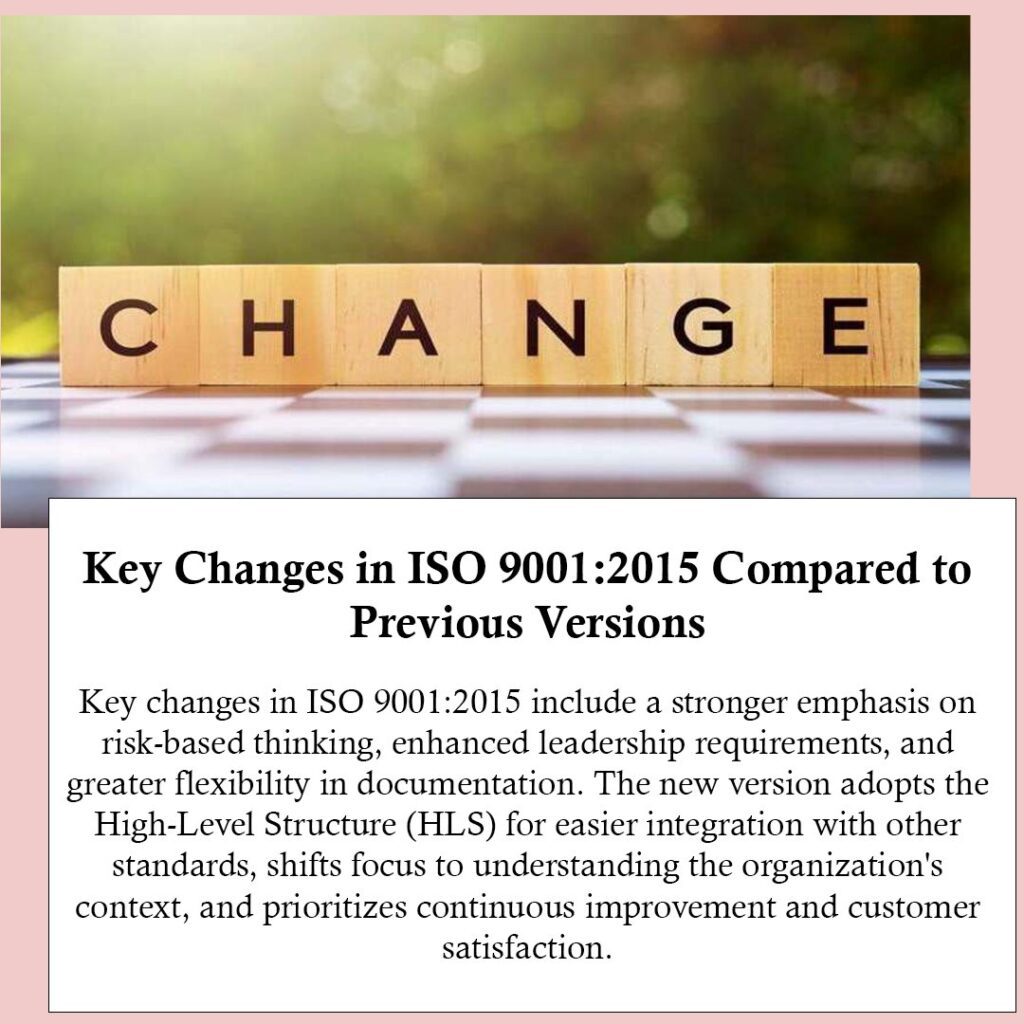Subtotal $0.00

ISO 9001:2015 introduced several significant changes compared to its predecessor, ISO 9001:2008. These updates were designed to ensure the standard remains relevant in a rapidly evolving business environment and to better address the needs of modern organizations. This comprehensive overview highlights the key changes in ISO 9001:2015, explaining their importance and implications for businesses.
1. Adoption of the High-Level Structure (HLS)
One of the most notable changes in ISO 9001:2015 is the adoption of the High-Level Structure (HLS), also known as Annex SL. The HLS provides a common framework for all new and revised ISO management system standards, ensuring consistency and compatibility across different standards such as ISO 14001 (Environmental Management) and ISO 45001 (Occupational Health and Safety).
Key Aspects of HLS:
Uniform Clause Structure: The HLS uses a standardized clause structure consisting of ten clauses, which simplifies the integration of multiple management systems.
Consistent Terminology: The use of consistent terminology across standards helps organizations understand and implement multiple standards more efficiently.
Aligned Requirements: The aligned requirements facilitate a more straightforward and cohesive approach to managing quality, environmental, and occupational health and safety aspects.
2. Emphasis on Risk-Based Thinking
ISO 9001:2015 places a stronger emphasis on risk-based thinking compared to previous versions. This approach requires organizations to identify and address risks and opportunities that could impact the quality management system (QMS) and its ability to achieve intended outcomes.
Key Aspects of Risk-Based Thinking:
Proactive Risk Management: Organizations are encouraged to take a proactive approach to managing risks, rather than merely reacting to problems after they occur.
Integration into Processes: Risk-based thinking is integrated into various processes within the QMS, ensuring a comprehensive approach to identifying and mitigating risks.
Focus on Opportunities: Alongside risk management, there is also a focus on identifying opportunities for improvement and innovation.
3. Greater Leadership Involvement
ISO 9001:2015 enhances the role of leadership in the QMS. Top management is expected to take a more active and accountable role in ensuring the effectiveness of the QMS and aligning it with the organization’s strategic direction.
Key Aspects of Leadership Involvement:
Leadership Commitment: Leaders must demonstrate a commitment to quality management by taking responsibility for the QMS and promoting a quality-focused culture.
Strategic Alignment: Quality objectives should be aligned with the organization’s strategic goals, ensuring that quality management supports broader business objectives.
Engagement with Stakeholders: Top management should engage with stakeholders, including employees, customers, and suppliers, to foster a collaborative approach to quality management.
4. Focus on Organizational Context
Understanding the context of the organization is a new requirement in ISO 9001:2015. Organizations must consider both internal and external issues that can impact the QMS.
Key Aspects of Organizational Context:
Context Analysis: Organizations are required to analyze their internal and external environment to identify factors that could affect the QMS.
Stakeholder Needs and Expectations: Identifying and addressing the needs and expectations of relevant stakeholders, including customers, employees, suppliers, and regulatory bodies, is essential.
Strategic Alignment: The context analysis helps ensure that the QMS is aligned with the organization’s strategic direction and is capable of responding to changing circumstances.
5. Simplified Documentation Requirements
ISO 9001:2015 introduces more flexible documentation requirements compared to the previous version. The term “documented information” replaces “documents” and “records,” reflecting a broader approach to managing information.
Key Aspects of Documentation Changes:
Flexibility: Organizations have more flexibility in determining the extent and type of documented information needed to support their QMS.
Focus on Value: Documentation should add value to the QMS and be useful for managing quality, rather than being a bureaucratic requirement.
Electronic Records: The standard acknowledges the use of electronic records and other modern methods of managing information.
6. Enhanced Focus on Performance Evaluation
Performance evaluation is given greater emphasis in ISO 9001:2015. Organizations are required to monitor, measure, analyze, and evaluate their QMS to ensure its effectiveness.
Key Aspects of Performance Evaluation:
Data-Driven Decision Making: Organizations should base decisions on the analysis of data and evidence, ensuring that actions are justified and effective.
Monitoring and Measurement: There is a stronger focus on regular monitoring and measurement of processes and outcomes to identify areas for improvement.
Internal Audits and Management Reviews: Internal audits and management reviews are critical components of the performance evaluation process, helping to ensure continuous improvement and compliance with the standard.
7. Process Approach
While the process approach was present in ISO 9001:2008, ISO 9001:2015 further strengthens its application. Organizations are required to systematically define and manage processes, ensuring they are interconnected and aligned with the QMS.
Key Aspects of the Process Approach:
Process Mapping: Organizations should identify key processes, understand their interactions, and ensure they contribute to the overall effectiveness of the QMS.
Process Ownership: Assigning ownership and responsibility for processes helps ensure accountability and effective management.
Continual Improvement: The process approach supports continual improvement by enabling organizations to identify inefficiencies and implement changes.
8. Consideration of Interested Parties
ISO 9001:2015 requires organizations to identify and consider the needs and expectations of interested parties that could impact the QMS.
Key Aspects of Interested Parties:
Stakeholder Analysis: Organizations should conduct a stakeholder analysis to identify relevant parties and their requirements.
Engagement and Communication: Engaging with stakeholders and maintaining effective communication channels is essential for understanding and addressing their needs.
Impact on QMS: The needs and expectations of interested parties should be considered when developing and implementing the QMS, ensuring it remains relevant and effective.
Conclusion
The key changes in ISO 9001:2015 reflect a shift towards a more integrated, flexible, and strategic approach to quality management. By adopting the High-Level Structure, emphasizing risk-based thinking, enhancing leadership involvement, focusing on organizational context, simplifying documentation, and strengthening performance evaluation, ISO 9001:2015 ensures that the standard remains relevant and effective in today’s dynamic business environment. These changes help organizations build robust quality management systems that not only ensure the consistent delivery of high-quality products and services but also support strategic goals, foster continuous improvement, and enhance stakeholder satisfaction.